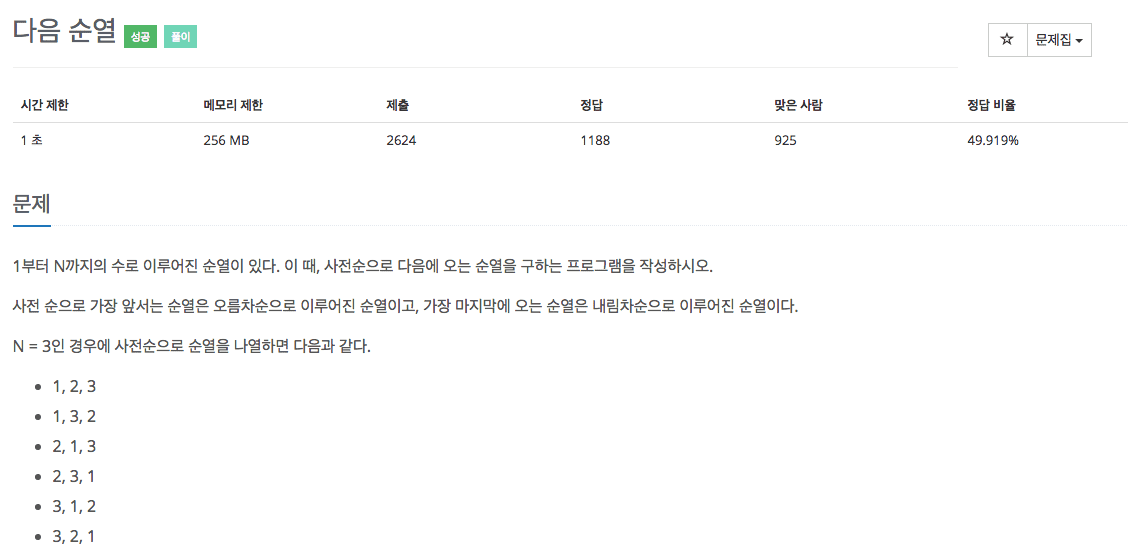To Do
- 순열을 사전순으로 나열 했을 때, 사전순으로 Next or Prev 순열을 찾는 방법에 대해 알아보자.
- 1) STL 함수 사용
- 2) 직접 구현
- 같은 Logic Problem : 10973 이전 순열 / 10974 모든 순열
Key Point
-
n값에 따라 앞에서 부터 n자리까지만 순열을 구한다.
-
do ~ while이 아닌 while문을 사용하게되면 다음과 같은 문제가 발생한다.
123
132가 아닌
즉 123상태에서 이미 swap을 시키게 된다.
132부터 시작한다.
- next or prev permutation의 Return Value에 대해 알아보자.
next_permutation(v.begin(),v.end());
/*
만약
vector에 1 2 3 4 가 있다면
1 2 4 3 으로 순열을 구할 수 있기 때문에
Return Value는 1이 된다.
하지만
vector에 4 3 2 1 순서로 있다면
더이상의 순열을 구할 수 없기 때문에
Return Value는 0이 된다.
*/
next_permutation()
- 작은 값 -> 큰 값 순서로 진행된다.
#include<iostream>
#include<algorithm>
using namespace std;
int main(){
int arr[10];
for(int i=0; i<10; i++)
arr[i] = i;
int n = 3;
do {
for(int i=0; i<10; i++)
cout << arr[i] << " ";
cout << endl;
} while (next_permutation(arr, arr+n));
return 0;
}
/*
Output
n = 3일 때
0 1 2 3 4 5 6 7 8 9
0 2 1 3 4 5 6 7 8 9
1 0 2 3 4 5 6 7 8 9
1 2 0 3 4 5 6 7 8 9
2 0 1 3 4 5 6 7 8 9
2 1 0 3 4 5 6 7 8 9
n = 4일 때
0 1 2 3 4 5 6 7 8 9
0 1 3 2 4 5 6 7 8 9
0 2 1 3 4 5 6 7 8 9
0 2 3 1 4 5 6 7 8 9
0 3 1 2 4 5 6 7 8 9
0 3 2 1 4 5 6 7 8 9
1 0 2 3 4 5 6 7 8 9
1 0 3 2 4 5 6 7 8 9
1 2 0 3 4 5 6 7 8 9
1 2 3 0 4 5 6 7 8 9
1 3 0 2 4 5 6 7 8 9
1 3 2 0 4 5 6 7 8 9
2 0 1 3 4 5 6 7 8 9
2 0 3 1 4 5 6 7 8 9
2 1 0 3 4 5 6 7 8 9
2 1 3 0 4 5 6 7 8 9
2 3 0 1 4 5 6 7 8 9
2 3 1 0 4 5 6 7 8 9
3 0 1 2 4 5 6 7 8 9
3 0 2 1 4 5 6 7 8 9
3 1 0 2 4 5 6 7 8 9
3 1 2 0 4 5 6 7 8 9
3 2 0 1 4 5 6 7 8 9
3 2 1 0 4 5 6 7 8 9
*/
prev_permutation()
- 큰 값 -> 작은 값 순서로 진행된다.
#include<iostream>
#include<algorithm>
using namespace std;
int main(){
int arr[4] = {3,2,4,1};
int n = 3;
do {
for(int i=0; i<4; i++)
cout << arr[i] << " ";
cout << endl;
} while (prev_permutation(arr, arr+n));
return 0;
}
/*
Output
n = 3일 때
3 2 4 1
2 4 3 1
2 3 4 1
n = 4일 때
3 2 4 1
3 2 1 4
3 1 4 2
3 1 2 4
2 4 3 1
2 4 1 3
2 3 4 1
2 3 1 4
2 1 4 3
2 1 3 4
1 4 3 2
1 4 2 3
1 3 4 2
1 3 2 4
1 2 4 3
1 2 3 4
*/
[1] Problem
Problem URL : 다음 순열



Code
#include <iostream>
#include <algorithm>
#include <vector>
using namespace std;
bool next_permutation(vector<int> &a, int n) {
int i = n-1;
while (i > 0 && a[i-1] >= a[i]) {
i -= 1;
}
if (i <= 0) {
return false; // 마지막 순열
}
int j = n-1;
while (a[j] <= a[i-1]) {
j -= 1;
}
swap(a[i-1], a[j]);
j = n-1;
while (i < j) {
swap(a[i], a[j]);
i += 1;
j -= 1;
}
return true;
}
int main() {
int n;
cin >> n;
vector<int> a(n);
for (int i=0; i<n; i++) {
cin >> a[i];
}
/*
STL 함수 사용 법
*/
if (next_permutation(a.begin(),a.end())) {
// if (prev_permutation(a.begin(),a.end())) {
for (int i=0; i<n; i++) {
cout << a[i] << ' ';
}
} else {
cout << "-1";
}
/*
직접 구현한 함수 사용법
*/
if (next_permutation(a,n)) {
for (int i=0; i<n; i++) {
cout << a[i] << ' ';
}
} else {
cout << "-1";
}
cout << endl;
return 0;
}
[2] Problem
Problem URL : 차이를 최대로

Code
- 배열에 들어있는 값에 대해 next_permutation함수 사용하기
#include<iostream>
#include<algorithm>
using namespace std;
int main(){
ios::sync_with_stdio(0);
cin.tie(0); cout.tie(0);
int n;
int arr[10];
cin >> n ;
for(int i=0; i<n; i++)
cin >> arr[i];
int ans = -1;
sort(arr,arr+n); // [1]
do {
int tmp = 0;
for(int i=0; i<n-1; i++){
tmp += abs(arr[i] - arr[i+1]);
}
ans = max(ans,tmp);
} while (next_permutation(arr, arr+n)); // [2]
cout << ans << endl;
return 0;
}
-
[1] : 배열을 sort하는 법
-
[2] : 배열에 순열을 구하는 법